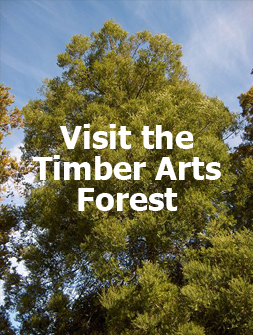Visit the Timber Arts Forest
As a result of the effects of the Covid-19 shutdown of the New Zealand border and economy our business will be closing down. Consequently all our timber stocks are for sale.
Please contact Ian Cragg on 0274 300267 or [email protected] for further information.
With more than 220 species of indigenous New Zealand tree, the New Zealand forest is a unique production of nature found in no other land.
As well as handcrafting items that reflect the value of this heritage and will be treasured for years to come, our work also serves to introduce New Zealanders and overseas visitors, alike to the beauty and wonder that is the New Zealand bush.
We use four main timbers: Kauri, Matai and Rewarewa and Rimu and a further fifteen in the composition of our designs. These timbers are chosen on the basis of their colours, grain patterns and workability, which lend them to be creatively used. They also need to be available on a sustainably managed basis in accordance with the Sustainable Forest Management Regime which is in force in New Zealand.
Kauri – Agathis australis
Matai – Prumnopitys taxifolia
Rewarewa – Knightia excelsa
Rimu – Dacrydium cupressimum
Hinau – Elaeocarpus dentaus
Kahikatea – Podocarpus dacrydioides
Kaikawaka – Libocedrus bidwillii
Kohekohe – Dysoxylum spectabile
Miro – Prumnopitys ferruginea
Pukatea - Laurelia novae-zelandiae
Puriri – Vitex lucens
Rata – Metrosieros robusta
Red Beech – Nothofagus truncate
Taraire – Beilschmiedia tarairi
Tawa– Beilschmiedia tawa
Tawhai / Silver Beech - Nothofagus menziesii
Tawhero / Towai – Weinmannia silvicola
Titoki – Alectryon excelsus
Totara – Podocarpus totara
Softwood
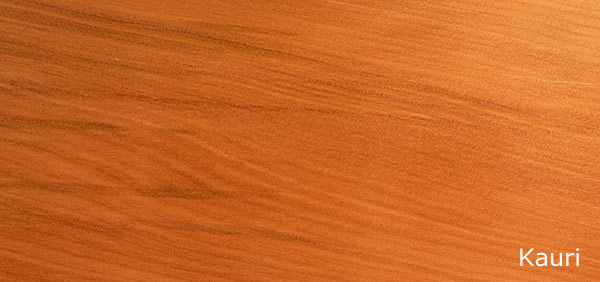
Kauri is the giant of the New Zealand forest and the most renowned of all our timber trees. Found only in the north of the North Island, it is to New Zealand what Jarrah is to Western Australia or Californian Redwood is to California – a tree and a timber of legendary fame and importance.
A height of 22 metres to the first branch and a diameter of 7 metres is recorded. Though no heights compared to those of the Sequoias and Eucalypts are recorded for the Kauri, it is unique in its almost entire lack of taper whilst extensive taper is the conspicuous feature of the Sequoias.
The first five places as giant trees appear to belong to the following: Redwood, New Zealand Kauri, Australian Eucalyptus Regnans, Californian Big Tree (Sequoia gigantean) and Oregon (Pseudotsuga Taxifolia).
The dry heartwood of Kauri is a light biscuit or buff-brown varying to yellow or reddish brown: the sapwood is a very light brown, sometimes brownish-white. The timber has a fine and even texture with a straight grain and while Kauri can be a bland timber, it can have a golden hue with a golden speckle, due to resinous rays, that makes the appearance of the timber quite stunning.
In its heyday Kauri was a superb multi-purpose timber; prized for ship’s spars it was extensively used for boat building, general house building and furniture and joinery.
In 1985 the felling of live old growth trees was prohibited unless the wood was required for nationally important purposes. The Kauri which we use in our work comes from stumps and head logs left behind on the forest floor, often over 100 years ago, when the milling of Kauri was taking place.
Matai – Prumnopitys taxifolia
Softwood
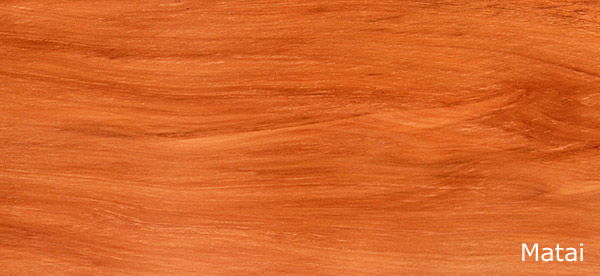
Matai is, along with Kauri and Totara, one of New Zealand’s finest native timber species. It is robust tree up to 25m in height with a trunk up to 1.3 metres in diameter and a broad crown held on stout, erect, spreading branches. It occurs throughout New Zealand in lowland forests but is most common in the central North Island, only locally abundant in the South Island and extremely rare on Stewart Island.
Matai timber is straight-grained, easily worked, strong, easily split and fairly hard. The dry heartwood of Matai is straw yellow to chestnut yellow, with an occasional reddish tinge. On exposure to air it darkens to a deep red-brown.
With its excellent machining qualities, dimensional stability and hardness the timber made a first class exterior joinery timber. It is one of the world’s great flooring timbers.
Hardwood
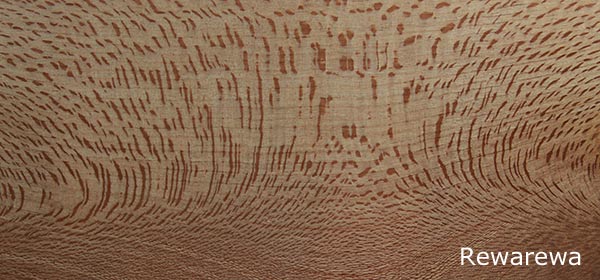
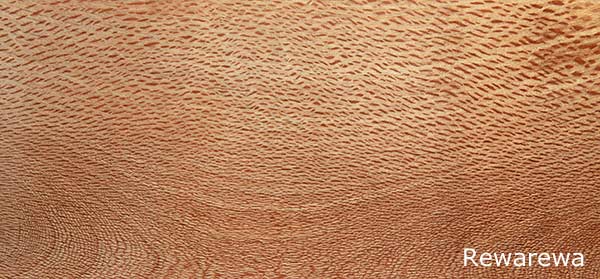
Rewarewa, also known as the New Zealand honeysuckle, is a tall upright tree up to 30 metres in height with a trunk up to 1 metre in diameter. It is one of the most distinctive looking of New Zealand’s native trees and specimens in the forest often reach 12 – 15 metres before the first branch arises. Rewarewa grows from sea level to 850 m and is found throughout the North Island and in the Marlborough Sounds at the top of the South Island.
The timber is strong, tough, elastic but workable; although difficult to season. The dry sapwood is silvery pinkish brown in colour while the heartwood is darker reddish to purplish brown with very prominent medullary rays. Rewarewa has a quite stunning appearance when quarter-sawn and depending on the cut of the log the appearance of these medullary rays can vary greatly between a tight and open pattern, thereby greatly altering the finished appearance of the wood. It can be vaguely suggestive of oak.
Because of its figured grain, there is a history of the wood being used in the early decades of European settlement for inlay and decorative work. These days, the figured grain makes it a timber which is popular with visitors to New Zealand.
Softwood
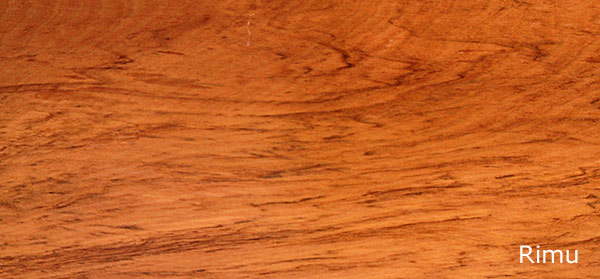
Rimu is probably the best known and most easily identified New Zealand native tree and can be recognised by its spreading crown with pendulous branchlets, which in young trees have a graceful, weeping, appearance. It is a very tall forest canopy tree, usually 20 – 35 metres in height but can reach 60 metres. It generally has a straight trunk that can be up to 1.5 metres in diameter and even larger in older trees, some of which are estimated to be 800 – 1,000 years old. Rimu was formerly abundant in lowland and hilly forests throughout the North, South and Stewart Islands from sea level to 600m.
Rimu is a fine, even textured medium density softwood. The seasoned heartwood, which can be beautifully figured, is reddish brown or occasionally yellowish with irregular pigmented streaks, while the sapwood has a lighter brown tone. The intermediate zone between the two is referred to as coloured Rimu and shows similar variations in colour though in lighter hues.
Once a widely used building timber – over 50% of the timber milled from the earliest days of saw milling in New Zealand was Rimu – the reduction in availability from the 1960’s on saw it being used mainly for furniture manufacture and interior panelling. Nowadays, the availability and cost is such, that it is used mainly by the specialty woodworker.
Hardwood
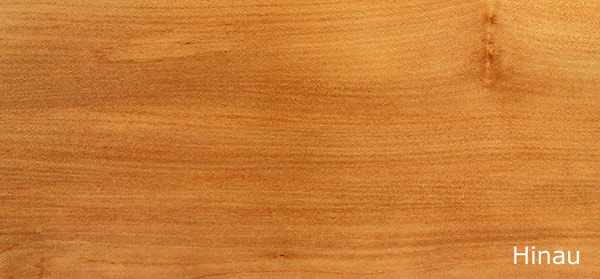
Hinau is a medium-sized evergreen forest tree of wide but sparse distribution. It occurs all over the North and South Islands in lowland forest from sea level to 600m. The tree can grow to a total height of 18m and to a diameter of 1m.High grade Hinau has been used for boat and motor-body building; furniture, bridge runners and decking (black heart or preservative treatment).
There is no clear distinction between sapwood and hardwood colour. Hinau has a fine, even texture with good mechanical strength and toughness and is a useful medium-density hardwood.
Kahikatea – Podocarpus dacrydioides
Softwood
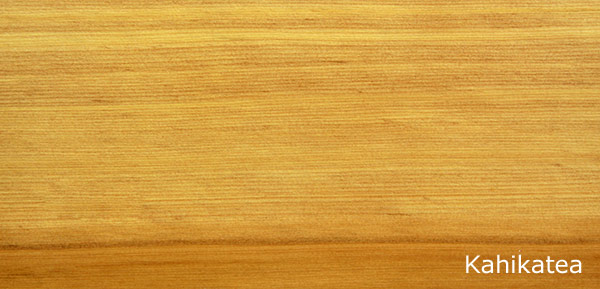
Kahikatea or White Pine is the tallest of the New Zealand native trees with mature specimens of up to 60m being recorded. In pure stands its form can be magnificent, with straight, unbranched trunks up to 30m or more. Its diameter at breast height can reach 180cm but it is more commonly 50-130cm. The trunk is often fluted and buttressed at the base. It is found in lowland forest up to 600m and semi-swamp forests in both the North and South Islands.
Dry heartwood, especially from old trees on hill sites, is fairly bright yellow. This is surrounded by a zone of paler heartwood while the sapwood is light creamy white. It is a light, straight, soft and easily worked timber completely free from odour and taste.
Kahikatea was extensively used for butter boxes, cheese crates and dairy machinery in the early days of the development of the New Zealand dairy industry. The timber, with its freedom from taint, its whiteness and its ability to withstand rough usage, when combined with its easy-working properties, has not been matched by any other timber. It has always been associated with boat building because it is light and easily worked and with kitchen woodware because of its freedom from odour and taste. Other uses have been in the building industry where it has been used for fascia boards, mouldings, window sashes and feature panelling.
Kaikawaka – Libocedrus bidwillii
Softwood
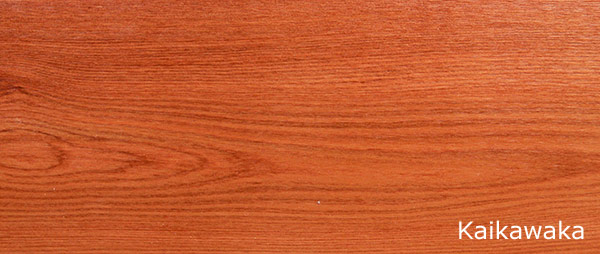
Kaikawaka or New Zealand Cedar is a small to medium-sized tree found principally in the forests of wet mountainous districts throughout New Zealand except Fiordland. It grows to a height of between 12m to 18m and the trunk can be as much as 1m in diameter but is usually 30-60m through.
The timber is somewhat similar to Californian Redwood but lighter and less durable. The heartwood is dull red in colour and the sapwood light pinkish brown. It is a low density straight grained wood which splits very easily and it is not a good turning or machining wood as it is soft and brittle. It is the weakest of New Zealand’s softwoods as far as mechanical properties are concerned.
Because of its resistance to burning it has been used for fire doors. Other uses have been roof shingles, boat planking and weatherboards.
Kohekohe – Dysoxylum spectabile
Hardwood
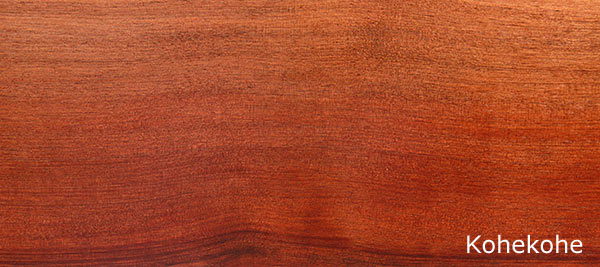
Kohekohe is a small handsome tree up to 15m tall. The trunk can be up to 1m in diameter but anything over 60cm is likely to be hollow. It once formed extensive tracts of coastal and lowland forest in damp situations from North Cape to Nelson, but these have now mostly disappeared in the face of settlement and damage by opossums.
The heartwood of Kohekohe is an attractive light reddish brown with a fine even texture. The sapwood is a clear brownish white. In some trees the wood can be brownish white all the way through and there is a propensity for larger logs, where there is a reasonable amount of heart timber, to be hollow. The heartwood can have a lustrous sheen on the radial surface but is extremely blunting on steel woodworking tooling.
Kohekohe was used as a furniture and cabinet-making wood due to its colour and with its similarity to Honduras Mahogany, to whose family it belongs. In recent times its use has been limited to craft furniture.
Miro – Prumnopitys ferruginea
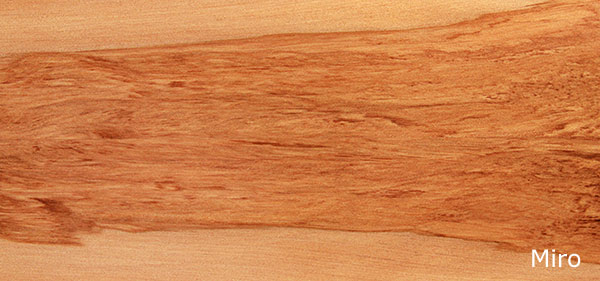
Miro is a medium sized round-headed forest tree forest tree up to 25m high with a trunk up to 1m across. It is a slow-growing tree, preferring shady situations and is found all over New Zealand in lowland forest to an altitude of 1,000m.
Miro heartwood is light biscuit brown with greyish tinge and dark reddish or blackish streak. Sapwood seasons from yellowish white to dull brownish white. The grain is moderately straight and while the figure is not as rich as Rimu, it is often mistaken for that timber.
Miro was used as a substitute for Matai in weatherboarding and flooring, interior finishing and furniture.
Pukatea - Laurelia novae-zelandiae
Hardwood
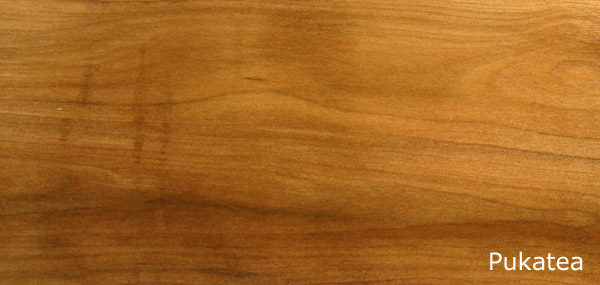
A tall forest tree up to 36m high with a trunk up to 2m in diameter, Pukatea grows best in damp and wet places. In the forest it grows tall with a clean, straight trunk, free of branches for some distance from the ground and may be distinguished by the large flange-like buttresses at its base which support the trunk. Pukatea grows from sea level to 600m in swampy forests, damp gullies and creek beds. It is widely distributed in North Island forests, though never in great abundance and is found in Marlborough and the West Coast of the South Island down as far as Fiordland.
Pukatea heartwood is an even dull greyish brown, often with a green tinge, sometimes streaked. The sapwood is brownish white. The timber is a lightish, soft, easily nailed hardwood with properties more like a softwood and is usually easy to saw and machine. The grain is generally straight.
High grade Pukatea has been used in the past, especially in early European times, for boat and motor-body building, weatherboards, trellis laths, bottle stoppers, wedge heels, clogs, mining sluices and veranda floors.
Hardwood
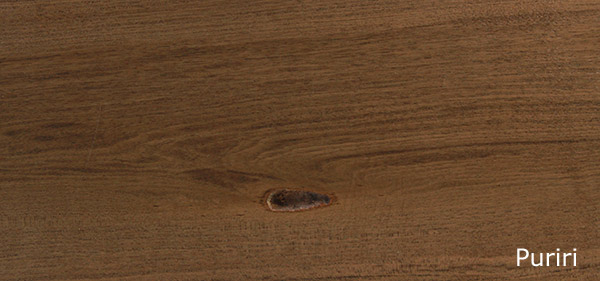
Puriri, belonging to the same family as teak, is a massive, handsome tree up to 20m tall with a trunk up to 1.5m in diameter. It bears stout, spreading branches with four angled branchlets.
The wood of Puriri is one of New Zealand’s most valuable hardwoods though there has been, historically, very little produced. Dark reddish-brown in colour with a green tinge, it is very heavy and dense in texture and is great strength and durability. The grain is irregular and uneven however, making the wood difficult to work. It is also often spoiled by the Puriri moth.
Puriri was used in the early days of European settlement for purposes requiring great strength and durability but supply could not match the demand. Some of these uses were house piles, railway sleepers, culverts, bridges, ship blocks, machine beds and bearings.
Hardwood
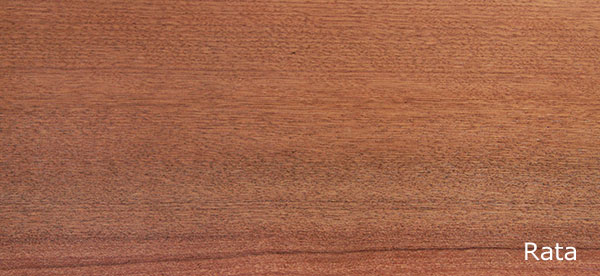
Rata is one of the giants of the forest, some old Rata tress having massive trunks and huge spreading crowns. A Rata tree can be up to 25m high with a trunk up to 2.5m in diameter.
There are two distinct species of Rata. Metrosieros robusta, which is found all over the North Island and in the north-west of the South Island, is generally called Rata. M. umbellate (called Southern Rata, even though it does occur in the north) is found all the way down the western side of the Southern Alps to Stewart Island. It ascends from sea level to about 900m and in places it is the dominant tree in the forest.
Rata is a remarkable tree that frequently, but not invariably, commences life as an epiphyte on another forest tree. It then sends down aerial roots that eventually reach the ground and, at the same time horizontal side roots grow around the host’s trunk until, in time, the host tress’s trunk is completely enclosed in that of the Rata
Southern Rata is a legitimate, much-branched tree, growing from the ground to a height of 15m with a trunk up to 1m in diameter.
Both species of Rata are very heavy hard woods although, with the higher density, Southern Rata is the harder of the two and, in fact, is reputed to be the second hardest timber in the world after lignum vitae. Both woods have dark reddish brown or plum-coloured heartwood with purplish streaks through it. It is a colour rare among hardboards
Rata was used around the early days of European settlement for many jobs requiring hardness, strength and durability. It was not as durable as Puriri though and like the latter was never available in any quantity. It has been used for boat building.
Red Beech – Nothofagus truncate
Hard Beech
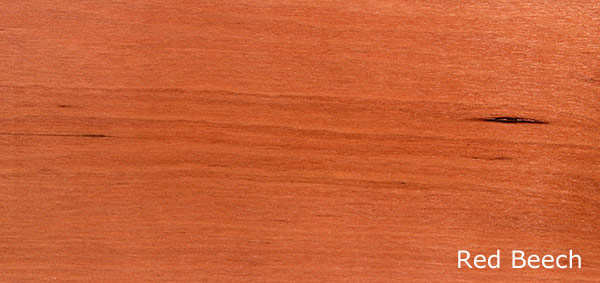
Red Beech is a tall, frequently massive forest tree averaging 24 - 30m in height with a trunk 1.5 - 2m in diameter which is often prominently buttressed. Trees up to 42.7m tall and 3m in diameter have been measured. This species of beech is found in lowland and montane forests, south of latitude 37 deg., mainly from East Cape to Cook Strait in the North Island and north of Arthur’s Pass in the South Island. It can also be found in and to the north of, the Otago lake country.
Red Beech is a strong, compact, hard and tough timber: more durable than the other beeches it is moderately easy to split. The heartwood is light to medium red-brown and the sapwood, light brown while the grain is generally straight with a slight figure and the texture is fine and even. The timber in the past has been notoriously difficult to dry, however modern developments in drying procedures and a greater understanding of the timber have reduced this problem. Once dry, Red Beech is the most stable New Zealand timber and works well.
Principal uses in the past have been bridges, decking, posts, mine timber, fluming, framing, flooring, stock yards, gates, hurdles, dowels, handles: generally an alternative to Australian hardwoods.
Taraire – Beilschmiedia tarairi
Hardwood
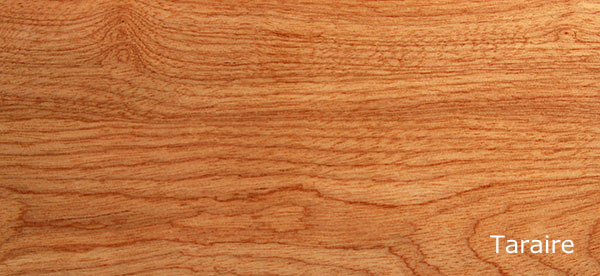
Taraire, with its straight trunk and fine bold foliage, is a handsome forest tree found only in the forests of the far north and was once the most common medium-sized understory tree of New Zealand’s Kauri forests. It grows to a height of up to 22 metres with a slender trunk of up to 1m in diameter.
Taraire heartwood is an even light brown colour; the sapwood is paler. The wood is close-grained, light and easily worked: however it is not very durable.
Taraire, the wood, does not appear to have been of any particular significance to either the Maori or early European settlers. However in more recent times it came to be for flooring, furniture and mouldings. It is highly regarded in the north of New Zealand for furniture and turnery.
Hardwood
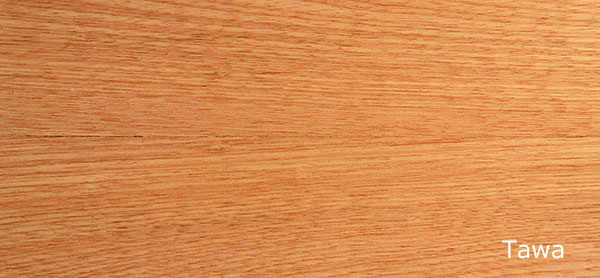
Tawa is a medium-sized to tall, erect forest tree with a graceful willow-like foliage. It reaches 25m in height with a spreading crown and a trunk up to 1.2m in diameter and is the most abundant hardwood tree in North Island lowland mid-altitude forests. It is found throughout that island and in the South Island as far south as Westport on the West Coast and the Clarence River in the east from sea level to 800m.
Tawa timber is straight grained, easily worked, rather hard, brittle and easily split. Dry heartwood is bright, creamy brown except for contrasting dark brown to black pathological heart in large logs. The sapwood is difficult to distinguish from white hard heartwood. The heartwood is akin to Oak in its finishing and strength qualities but it is poor on lasting qualities.
Tawa has always been a speciality timber, highly sought after for a few specific purposes. It is, or has been, a handy furniture timber, an excellent handle and dowel timber and the best species in New Zealand for turning across the grain e.g. for drawer knobs. It can be stained and polished readily.
Tawhai / Silver Beech – Nothofagus menziesii
Hardwood
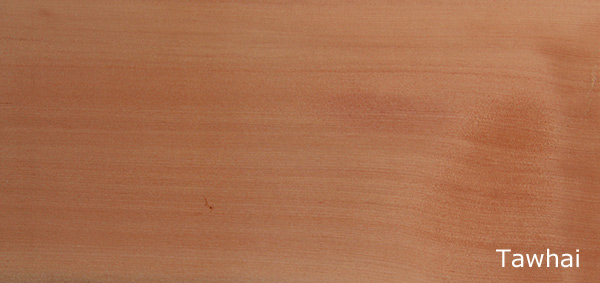
Tawhai in the forest is a tall tree with its spreading branches arranged more or less in tiers. In the open, this beech forms a broad, spreading, magnificent dome-shaped tree with its lower branches arching towards the ground. Within the forest, the main stem is straight and cylindrical with little taper and it usually has no branches for more than half tree height. It averages 20-25m in height with a trunk 0.6-1.5m in diameter and occurs in lowland and montane forests south of latitude 37 deg.
Tawhai is a straight grained, strong, tough, compact and workable timber. The dry heartwood can vary from reddish to pinkish brown to pinkish white while the dry sapwood is light greyish pink.
Principal uses of high grade Tawhai have been furniture, implements, turnery, motor bodies, boat frames, brush backs, flooring, interior finish and weatherboards.
Tawhero / Towai – Weinmannia silvicola
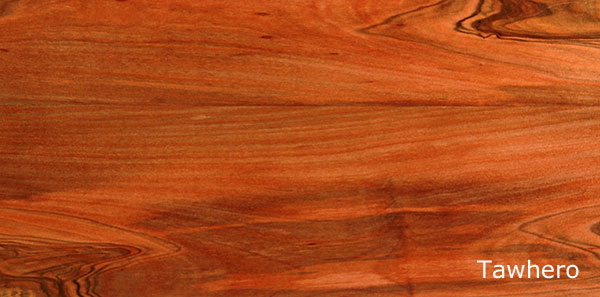
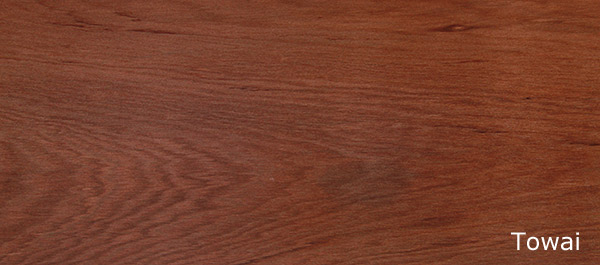
Tawhero, also known as Towai, forms a canopy tree up to 15m high with a trunk up to 1m in diameter. It grows in lowland forests and along forest margins from Mangonui to the Waikato and Bay of Plenty.
Its use is very much restricted to the specialty woodworker.
Hardwood
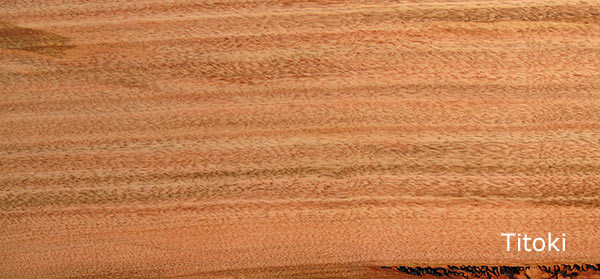
Titoki is found in coastal and lowland forests of the North and South Islands from North Cape to Banks Peninsula on the east of the South Island and further south in Westland. It is a handsome tree with a short stout trunk up to 60cm in diameter.
The heartwood is light red in youngish trees but bright red in larger and older ones; the contrast with the pale sapwood can be striking. The wood is hard and strong but not durable.
Over 100 years ago Titoki was regarded as suitable for purposes which demanded great strength and elasticity but did not involve any great amount of exposure to the weather. Today it is of interest to wood turners and the occasional furniture maker.
– Podocarpus cunninghamii (formerly P.Hallii – Halls Totara)
Softwood
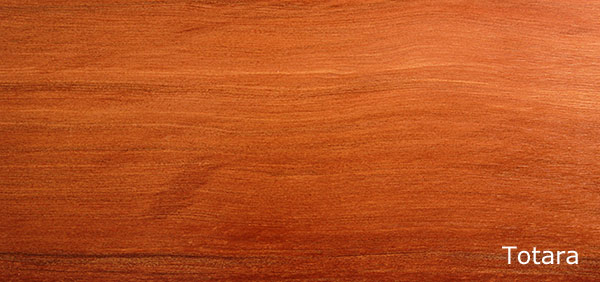
The name Totara is commonly applied to two tall slow growing forest trees -Podocarpus totara and P. cunninghamii, known as Halls Totara. P. totara is the taller of the two, a massive tree growing to a height of around 30m with a straight trunk up to 20m and a diameter of up to 2.5m: Specimens have been known to grow to 40m, 3m in diameter and to be 800 or more years old with one in the King Country, believed to be 1,800 years old. Unlike Kauri, the trunk of the larger Totara tree is frequently hollow
The two trees are best distinguished from one another by their bark: thick stringy and usually deeply furrowed on P. totara, but thin, flaky and rather paper like on P. cunninghamii. In its early stages a Totara forms a spreading, bushy and attractive tree. As it gains height it acquires a massive trunk and branches that bear dense foliage. Older trees become more open in habit and the top tends to die back. Enormous roots spread out over the ground at the base of the trunk.
Totara is found in lowland, mountain and subalpine forests from the far north of the North Island to the south of the South Island and Stewart Island. Both are found often growing together but P. totara usually gives way to P. cunninghamii above 480m.
The heartwood of Totara is an even reddish brown and the sapwood pale brown. The timber is straight grained, easily split, easily worked, fairly soft, stable but brittle
Totara was prized by Maori as being the best for building their massive war canoes and was also the main timber used for carving. It was a godsend to frontier farmers of New Zealand: widely available, easily split and durable in the ground, it was the ideal fencing timber. It was also highly sought after for house piles and was valued for bridge and wharf construction.
In recent times craftspeople are using Totara fiddle-back and burr to produce some stunning wood pieces.


